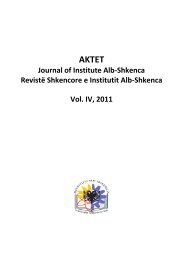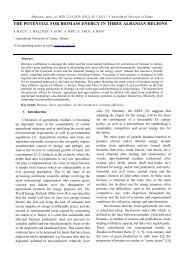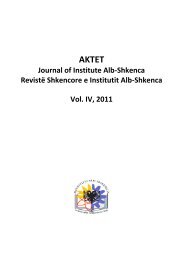You also want an ePaper? Increase the reach of your titles
YUMPU automatically turns print PDFs into web optimized ePapers that Google loves.
Lamaniaccompanied by the increasing of the ductility),but mainly by the reduction of the martensitictransformation hardening effect. In fact, the rateof this transformation for the AISI 321 steel,gradually decreases with the temperature risingand becomes practically negligible fortemperatures above 150ºC [10]. Processedresults of the test performed at 400ºC, show thateven at this temperature the material behaviorremains differentiated in two zones, but thisdifferentiation is much smaller. Specifically, if at18ºC, the exponent n increases by 2.31 times, at400ºC this increase is only 1.8 times. Since thelast one cannot be explained by the effect ofmartensitic transformation, it appears that withinthe austenitic structure operates a hardeningmechanism more complex than that modeled byHollomon's equation. The confirmation of thisassertion requires further investigation, but wecan say that for all practical purposes, theassessment of the hardening rate at 400ºC(Hollomon's equation), remains valid, since theoverall correlation in both zones is over 0.98.Simultaneous influence of temperature and timeare studied by keeping the gas pressure in thecell unchanged. These tests, which characterizethe material behavior in accelerated creep, areperformed at two temperatures: 600 and 620ºC(fig. 8).Figure 8 Effect of the test duration at 600 and620ºC on the rupture pressure.It seems that the influence of the time in thedecreasing of the rupture pressure is reducedwith time duration of the test. So, the two firsthours of stay at high temperatures cause adecrease in rupture pressure of about 20%, whilstthe prolongation of the stay from 5 to 7 hourscauses a reduction by only 3-3.5%. Therelationships found allow predicting the rate ofstrength decrease during a not very long stay (inthe case of a breakdown, for example) attemperatures close to 600-620ºC.CONCLUSIONS1. The disk testing can be successfully used forcharacterizing the materials behavior underbiaxial loading, giving a more direct information(particularly, in the case of pressure vessels) thanthe tensile test. For true strain rate up to 20%,the results of both tests match well.2. The disk test is more sensitive to hardeningphenomena related to the deformation of thematerial; it highlights better the hardening effectcaused by the martensitic transformation.3. The calculation model, used in this study,reliably simulates the material behavior in thearea between the onset of yielding and the pointat which necking begins. It does not cover theelastic region.4. The rise of temperature up to 650ºC leads toan important reduction of the load-bearingcapacity of the investigated steel (more than 2.5times). The duration of the tests affects the steelin the same direction, but this influence tends todecrease with time.LITERATURE1. ISO 11114-4 (2005), Transportable gascylinders - Compatibility of cylinder and valvematerials with gas contents.2. Fidelle J., Jouinot P., Stasi M., Barthélémy M.(1994) The range of application of disk pressuretest, Proceedings of 5 th International Conferenceon hydrogen effects on material behavior,Jackson Lake, USA, 73-78.3. Gantchenko V., Jouinot P., Stasi M. (1999)Etude des Matériaux par des Essais de Disquessous Helium, Matériaux&Techniques, Nº 11-12,53-59.4. Jouinot P., Gantchenko V. (2008)Caracterisation thermomécanique et192AKTET Vol. IV, Nr 2, 2011






